What Is Filtered Water and Is It Healthier Than Tap?
Updated: Mar. 08, 2022
Filtered water may taste better than tap, but is it healthier? Learn about filtration methods and how to find the best water filter for your needs.
Our editors and experts handpick every product we feature. We may earn a commission from your purchases.
Finding the best water for you
Everyone knows that it’s important to drink water every day to stay hydrated. Figuring out the best type of water for you, however, isn’t always as easy.
There are different types of water—bottled, filtered, and purified, among them.
Home-filtered water strikes a balance between healthfulness and affordability, according to Marvin Singh, MD, gastroenterologist and founder of Precisione Clinic in San Diego.
That is, it’s free of the impurities that you might get from the tap, but it won’t cost you an arm and a leg to restock your fridge. (Or clutter up the environment with single-use plastic.)
But some people prefer glass-bottled spring water because many water treatment systems filter out healthy minerals like calcium, magnesium, chloride, and potassium, says Amy Gorin, a registered dietitian and owner of Plant-Based Eats in Stamford, Connecticut.
What is filtered water?
There are many water treatment technologies, but the goal is the same: to remove contaminants from your drinking water.
Pitcher filters use activated carbon filters, while whole-house or under-sink systems often use reverse osmosis. The four primary water filtration methods are:
- Activated carbon filter: Most commonly used in pitcher-type filters, activated carbon bonds to contaminants, trapping them in the filter so that they do not flow through into your cup, according to the Environmental Protection Agency (EPA). This removes visible sediment and some metals, but it might not remove bacteria or arsenic.
- Ion exchange: This type of filtration system is used to soften and demineralize water. It is not commonly used to remove unhealthy toxins.
- Reverse osmosis (with carbon): Dr. Singh recommends this filtration method, which uses carbon and tight membranes to filter contaminants at the molecular level. Reverse osmosis can remove bacteria, viruses, and common chemical contaminants.
- Distillation: Distilled water is boiled into steam, then allowed to condense back into a liquid in a separate container. Contaminants in the steam remain trapped in the original container. Distilling water is very effective, but sometimes bacteria can recolonize as the water cools.
(This is what happens when you drink enough water.)
Why do people filter their water?
Most people filter their water because they worry about contaminants or don’t like the taste of tap water.
Water in cities, which comes from a municipal source, sometimes has hints of chlorine, which is used to kill any germs that could be harmful. Well water, on the other hand, can taste sulphuric, metallic, or even musty.
But many water contaminants don’t add flavor at all. That’s why Dr. Singh says drinking unfiltered water is unwise.
“There are so many contaminants that can be found in tap water,” he says. “These contaminants can be potentially harmful to our gut microbiome and overall health.”
One tap water additive you might want to keep—fluoride.
The mineral has been added to drinking water for nearly 100 years because it has been shown to prevent cavities. About 63 percent of the U.S. population has fluoridated water, according to 2018 data.
Reverse osmosis or distillation are more likely to remove fluoride, while it’s less likely to be removed by other filtering methods. Bottled water generally doesn’t contain fluoride.

Types of water contaminants
There are four types of water contaminants, according to the EPA. The federal agency sets standards for municipal water safety, so in general tap water is not supposed to exceed the legal levels for these contaminants.
However, keep in mind that the system doesn’t always work, as we’ve seen in Flint, Michigan and other cities. For example, tap water can travel through older pipes and pick up contaminants, like lead.
Here are the contaminants that can get in water:
- Physical: This includes any specks of dirt or dust, or any floating bits that you can see in your water.
- Chemical: This includes pesticides and metals such as lead, according to Dr. Singh. It can also include traces of chlorine or pharmaceutical drugs that have escaped into your water supply.
- Biological: “There can be a wide variety of bacteria, viruses, and parasites,” Dr. Singh says.
- Radiological: This includes cesium, plutonium, and uranium, according to the EPA.
Drinking contaminated water can lead to a variety of health problems, from flu-like symptoms to hormone imbalances, according to Dr. Singh. Lead, in particular, is dangerous for children.
How to know if your water is safe
If you’re worried about contaminated tap water, Dr. Singh suggests checking your zip code’s water quality on the Environmental Working Group’s website.
He warns that most contaminant legal limits have not been updated for years and adds that “legal limits do not necessarily mean the same thing as safe limits.”
If you have well water, Gorin recommends having it tested for contaminants. If your well water is deemed safe, she says it can “be a wonderful source of health-benefiting minerals.”
Filtered versus purified water
Technically, filtered water could be water that has been physically strained through a mesh sieve, activated carbon filter, or something else.
Purified water has been filtered through reverse osmosis, distillation, nanotechnology, or even ultraviolet (UV ) light to remove physical, chemical, and bacterial contaminants.
Because no water filtration system removes 100 percent of the contaminants, there is no pure water on the market. Instead, most filtered or bottled water is labeled “purified.”
What about bottled water?
Sixteen percent of surveyed Americans say they drink only bottled water, while 10 percent stick to tap or filtered water only, according to 2018 research by market research company Statista. That means most consumers drink a mix of both.
If you enjoy bottled water, Dr. Singh says it is wise to research the water quality of various suppliers.
And both he and Gorin recommend opting for glass bottles over plastic.
Water in plastic bottles can contain tiny particles known as microplastics, although the health effects are unclear. Not only that, but plastic bottles contribute to environmental waste.
“There’s the environmental concern,” Gorin says. “If you have the capacity … get spring or mineral water from glass-bottled sources, such as Mountain Valley. You can even set up home delivery that provides water in large containers.”
To stay hydrated, she opts for a combination of bottled spring water, mineral water, and custom-filtered well water.
Types of water filters and purifiers
Not all water filters and purifiers are created equally.
Here are the differences between pitcher and refrigerator filters, faucet filters, and reverse osmosis water purifiers.
Pour-through filtration: pitchers and refrigerators
It might surprise you to learn that the primary function of refrigerator and pitcher water filters is simply to make your water taste better.
Knowing that, it shouldn’t come as a shock to learn these “pour through” filters are less effective at reducing lead than point-of-use faucet filters or under-the-sink filters.
Your pitcher filter might also be ineffective against arsenic poisoning. In a 2017 study of five common water filter pitchers, published in the scientific journal Environmental Research, only one brand—ZeroWater—effectively reduced arsenic below the EPA’s maximum contaminant levels.
Individual pitcher filters are more affordable than under-the-sink filtration systems. But if you worry about tasteless contaminants, it’s best to invest in a point-of-use filtration system.
Point-of-use filtration: faucet and under-the-sink filters
Filtering your water at the tap means that all the water you use—for cooking, drinking, or even wiping up spills on the kitchen counter—has been purified.
These systems often utilize solid block activated carbon (SBAC) rather than granular activated carbon (GAC), which is common in disposable pitcher filters.
Point-of-use systems also often use reverse osmosis filtration.
Point-of-use filters are more reliable at removing lead and other particulates, according to a 2017 research review in Environmental Health Insights.
They are also available at a variety of price points, running in the hundreds of dollars.
Whole-house water filters
If you’re willing to put down a lot of cash for tasteless, odorless water, a whole-house system might be right for you.
These filtration systems come in a variety of technologies: carbon, reverse osmosis, and even ultraviolet light disinfection.
Whole-house systems can cost anywhere from hundreds to thousands of dollars, but they have the added benefit of filtering water throughout the house, from the bathroom to the kitchen.
Is filtered water worth the cost?
The answer to this question depends on your location, water source, and personal health concerns.
Filtered water is likely to be healthier, and it is critical if you live in an area at risk for contamination, according to Dr. Singh.
“I am biased toward filtered water at your home. It is very cost effective and reduces pollution,” he says. “I personally prefer a reverse osmosis system; you can find U.S.-made, BPA-free systems that only cost a few hundred dollars.”
However, it is also possible that you live in a home with soil and well water that contains healthy levels of essential minerals. That’s the case for Gorin.
“For optimal health benefits, I recommend drinking spring or mineral water—or well water, if you’ve had your water tested and it’s safe to drink—in the most environmentally friendly way possible,” she says.
(Find out if you’re drinking too much water.)
Tips for choosing a water filter
Based on our experts’ feedback, the CDC’s recommendations, and continuing research, here are the top tips for choosing your next water filter.
- Choose a filter or system certified by NSF International, an independent organization that sets recognized standards in this field.
- Opt for whole-house or point-of-use filtration if you can afford it.
- Pay attention to the “pore size” of your filter because smaller sizes catch more contaminants.
- If you have well water, get your water tested to determine whether you want or need a filtration system.
Next, these are the best ways to drink more water.




















